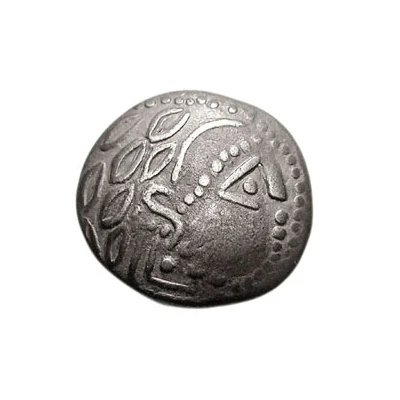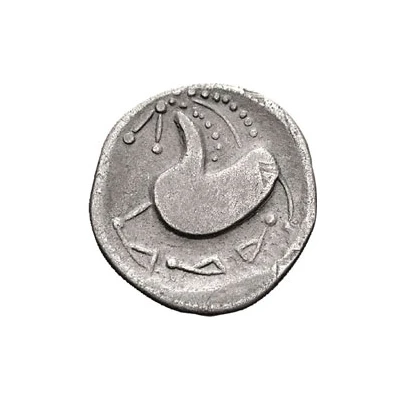


© Classical Numismatic Group, Inc.
Tetradrachm Schnabelpferd type 200 BC - 101 BC
| Silver | 12 g | 22 mm |
| Issuer | Costoboci (Dacians) |
|---|---|
| Type | Standard circulation coin |
| Years | 200 BC - 101 BC |
| Value | Tetradrachm (4) |
| Currency | Drachm |
| Composition | Silver |
| Weight | 12 g |
| Diameter | 22 mm |
| Shape | Round (irregular) |
| Technique | Hammered |
| Demonetized | Yes |
| Updated | 2024-10-09 |
| Numista | N#188436 |
|---|---|
| Rarity index | 92% |
Reverse
Interpretation in local style of horseman trotting left. Head of horse in the shape of a beak ("Schnabelpferd"). Thin legs with bold points at articulations and triangular hooves. Mane as pearled line. Rider stylised as a curve with pellets.
Comment
Imitation of Tetradrachm of Philip II of MacedonThis type is attributed to the north-east Carpathian tribes, likely to the Costoboci. Reverting to an earlier practice, these coins are commonly found cut.
Kostial lists weight at 9.10g
KMW 1133
Examples of this type:
• Example #1 (8.34g, 1h; Very Fine) - In main image
◦ Auctioned by Classical Numismatic Group, Triton IX, 10 January 2006, lot 632. Estimate 300 $.
◦ Auctioned by Peus, Auction 334, 4 November 1992, lot 13.
◦ From the Prof. T.R. Gurr Collection.
• Example #2 (9.90g, 2h; Good Very Fine):
© Image courtesy of Leu Numismatik AG
◦ Auctioned by Leu Numismatik, Auction 83, 6 May 2002, lot 525. Estimate 950 CHF.
• Example #3 (9.14g, 22mm, 12h; Good Very Fine):
© Image courtesy of Roma Numismatics Limited
◦ Ex-Hermann Lanz Collection; published in Kostial #666;
◦ Exhibited by the Staatlichen Münzsammlung München at the 1997 International Numismatic Congress in Berlin; at the Berliner Bank also in 1997; also exhibited at the Luitpoldblock Palmengarten, Munich in 2003 (exhibition #109[obverse]);
◦ Auctioned by Roma Numismatics Ltd, Auction XVIII, 29 September 2019, lot 167. Sold for 300 GBP.
◦ Auctioned by Münzenauktions GmbH Wien 1, 4 March 1985, lot 9.
• Example #4 (7.89g, 21mm, 3h, Very Fine):
© Image courtesy of Roma Numismatics Limited
◦ Ex-Hermann Lanz Collection; published in Michaela Kostial - "Kelten im Osten. Gold und Silber der Kelten in Mittel und Osteuropa, Sammlung Lanz", München, 1997, #670;
◦ Auctioned by Roma Numismatics Ltd, E-Sale 60, 1 August 2019, Lot 34. Sold for 260 GBP;
Interesting fact
One interesting fact about this coin is that it features a unique horse design on the obverse (front) side, which is unlike any other ancient coin design. The horse is depicted with a long, pointed snout, and its body is shown in a dynamic, galloping pose. This design is known as the "Schnabelpferd" type, which is German for "bill-horse" or "long-snouted horse." It's believed that this design was inspired by the Dacian people's love of horses and their skill in horse breeding and riding.